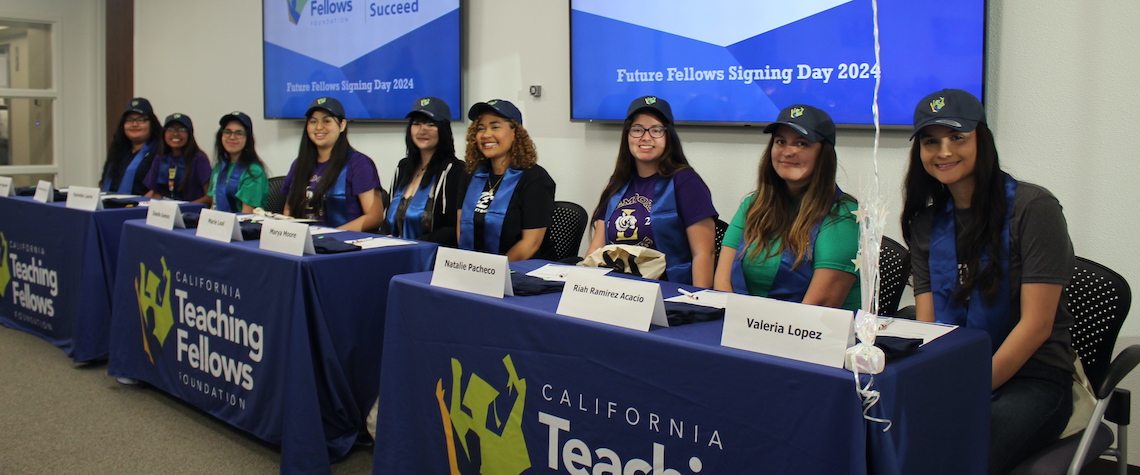
Participants in the California Teaching Fellows Foundation celebrate a “signing day” event for 2024, where they learn where they will serve in after school programs. Photo via California Teaching Fellows Foundation
Written by Dylan Gonzales
As California continues to deal with teacher shortages, leaders at the California Teaching Fellow Foundation (CTFF), a nonprofit that works in Fresno, Madera, Merced, Tulare, Kings and Sacramento counties, believe one of the best solutions is to start credentialing students working in after-school programs.
Mike Snell, the CEO at the CTFF, says that existing teacher preparation systems make it difficult for these individuals to transition into the classroom as credentialed teachers.
“We have about 4,000 tutors who want to become teachers who work for us,” Snell said. “A majority of those tutors are working in after-school programs. And to the best of our knowledge, in all of California and all of the United States, there’s not a single institution of higher education that’s offering a credential pathway for folks that work in after-school programs.”
The most recent report from the California Commission on Teacher Credentialing (CTC) found that while around 15,000 credentials were issued, the state’s need was closer to 25,000. The 10,000 gap is being met through provisional permits such as Short-Term Staff Permits (STSPs) and Provisional Intern Permits (PIPs), which do not require full credentialing.
Snell said the dependence on alternative certifications reflects wider challenges.
“We just think there’s got to be a better way,” he said. “Having a credentialed teacher in a classroom is essential for a young person to get a quality education, and the more and more that schools are having to make concessions and hire people who are not properly trained, the less quality education young people are going to receive.”
Other factors contribiting to the teaching shortage are personal and structural issues. Many after-school educators are first-generation college students who face financial constraints and are unfamiliar with the credentialing process.
“They’re the first in their family to go to college,” Snell said. “They’re having to try to navigate how to get a college degree, so that in itself is a challenge.”
Snell added that requiring credential candidates to leave the workforce during training is unrealistic for many aspiring educators.
“There are so many credential programs that require you not to work while you’re earning your credential, and that’s just not realistic,” he said.
Natalie Dodson, CTFF’s director of community development, said navigating the series of required assessments, such as the the California Basic Educational Skills Test (CBEST), California Subject Examinations for Teachers (CSET), Reading Instruction Competence Assessment (RICA) and Teacher Performance Assessments (TPAs), can be especially difficult without centralized support or guidance.
She also pointed to the volume of classroom-like experience after-school workers gain on the job. CTFF staff typically log between 750 and 800 hours of field experience per year, but Dodson said these hours don’t count toward credentialing.
“Wouldn’t it be wonderful knowing that they need to work and get paid, if those hours could count… and right now, that’s not happening, and that is an absolute barrier,” she said.
Snell said that they have been attempting to make progress with universities such as Fresno State and Fresno Pacific, but said, “there have been challenges, for whatever reason, in aligning credential programs with expanded learning after-school programs.”
Despite their struggles, Snell said the universities have been great partners with the CTFF and will continue to be.
Another challenge, according to Snell, is the scheduling of credential courses.
“We’ve got about 4,000 folks that work for us that want to become teachers, yet there’s not a single credential program that says we’re going to build a class schedule around folks that work in after-school programs,” he said.
The CTFF also acknowledges that the younger generation’s decreasing interest in teaching has contributed to the shortage.
Terence Wan, CTFF’s education pathways manager, shared the work that CTFF has to do to attract a new generation of teachers.
“I think it’s important for us to engage younger people sooner, to just kind of present to them these opportunities that they may not realize,” Wan said. “There are oftentimes a lot of negative connotations that come with the teaching profession, and so we want to be able to debunk those earlier.”
Snell stressed the importance of finding a way to get credentialed for after-school programs.
“We would love to be the first agency to work with institutional higher education to do this, but at the end of the day, what really matters the most to us is that youth workers throughout California find a way to have their after school hours count, to earn a credential and really begin to contribute to minimizing the teacher shortage, whether it happens here first in Fresno or somewhere else throughout the state, we don’t really care at the end of the day, as long as it happens,” Snell said.








